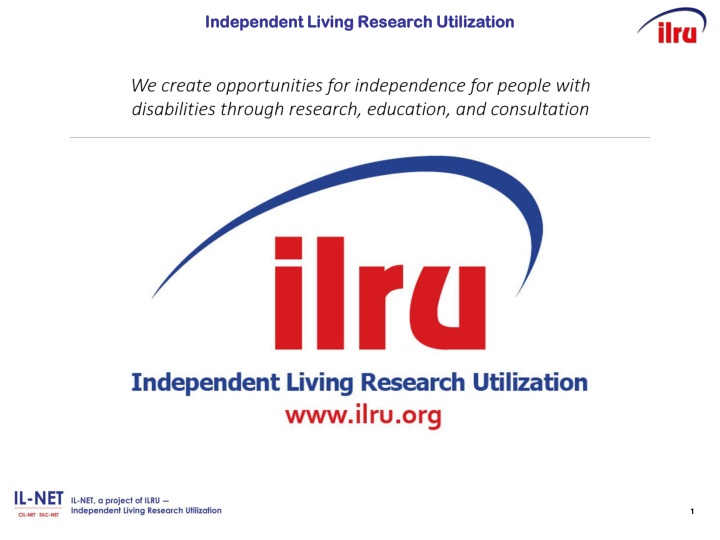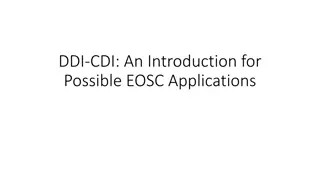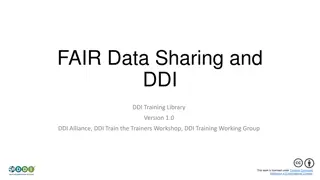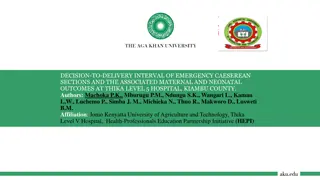
Susan's Journey to Disability, Diversity, and Intersectionality
Discover Susan's journey through disability, diversity, and intersectionality as she navigates discrimination and disparities. Follow her story from Detroit to community organizing, advocating for inclusivity and equity in society.
Download Presentation

Please find below an Image/Link to download the presentation.
The content on the website is provided AS IS for your information and personal use only. It may not be sold, licensed, or shared on other websites without obtaining consent from the author. If you encounter any issues during the download, it is possible that the publisher has removed the file from their server.
You are allowed to download the files provided on this website for personal or commercial use, subject to the condition that they are used lawfully. All files are the property of their respective owners.
The content on the website is provided AS IS for your information and personal use only. It may not be sold, licensed, or shared on other websites without obtaining consent from the author.
E N D
Presentation Transcript
Independent Living Research Utilization Independent Living Research Utilization 1
Susan Dooha Susan Dooha Kim Gibson Kim Gibson Reyma McCoy McDeid Reyma McCoy McDeid Ron Halog Ron Halog An American Journey: CIL Stories An American Journey: CIL Stories 2
CIDNY and Susan Doohas Story CIDNY and Susan Dooha s Story 3
We believe our mission includes a mandate to We believe our mission includes a mandate to remove barriers that are embedded in law, policy, remove barriers that are embedded in law, policy, structure, and practice; and it is these barriers that structure, and practice; and it is these barriers that result in disparities for people with disabilities, result in disparities for people with disabilities, which are much more extreme depending on your which are much more extreme depending on your race and ethnicity. race and ethnicity. ~ Susan Dooha, Executive Director ~ Susan Dooha, Executive Director Center for Independence of the Disabled in NY Center for Independence of the Disabled in NY (Manhattan) (Manhattan) 4
Susans Journey to Disability, Diversity Susan s Journey to Disability, Diversity & Intersectionality & Intersectionality Hometown Detroit: Great Migrations from the south, immigrants from the Middle East, Mexico, China. Discrimination huge issue in Detroit in housing; police; schools; jobs. Prominent leaders on local, state and national stage are racially/ethnically diverse including Grace Lee Boggs, Coleman Young, John Conyers, George Crockett. 5
Susans Journey to Disability, Susan s Journey to Disability, Diversity & Intersectionality, Diversity & Intersectionality, cont d. Community organizing and political action were family activities and diversity was highly valued: Schools segregated--so sent to integrated school. Civil rights marches and meetings. Community organizing on issues affecting the poor, Black, and Hispanic/Latinx communities. Electoral politics. 6
Susans Journey to Disability, Susan s Journey to Disability, Diversity & Intersectionality, Diversity & Intersectionality, cont d. 2 Experienced discrimination against my friends who were Black: Physical threats and actions Exclusionary cultural norms microaggressions Government and nonprofit jobs that focused on disability, race, ethnicity, LGBT and gender equity. CIDNY in 2002. 7
CIDNY Pioneers start by including people CIDNY Pioneers start by including people who were Hispanic/ who were Hispanic/Latinx Latinx on the Board of Directors Directors Strong beginnings in 1978 on a shoestring: CIDNY s first Executive Director was proud of both his disability and Puerto Rican identities. Another CIDNY leader was Hispanic/Latinx, Eduardo Drogue, who was a Panamanian American man with a disability. In 1980s Board included a Black Board member and Black staff members. on the Board of 8
CIDNY Pioneers progress in reflecting CIDNY Pioneers progress in reflecting the community...in a limited way... the community...in a limited way... From 1978-2002: Limited diversity on board, staff and management-- less than half of the staff were Black, Hispanic/Latinx. Few Hispanic/Latinx and no Asian Americans. Personnel policies only policies that speak to race/ethnicity and reflect affirmative action orientation. Strong focus on increasing the kinds of disabilities represented. 9
CIDNY Has an AHA moment and CIDNY Has an AHA moment and escalates change on purpose... escalates change on purpose... From 2002-2019: CIDNY observes its own lack of effectiveness in reaching Asian American communities. Policies and practices start to change: Community outreach and relationship building; Language capacity; Materials in translation; All policies shift to have a diversity focus. 10
CIDNYs AHA! moment continues by CIDNY s AHA! moment continues by getting the Board and top managers getting the Board and top managers onboard onboard ... ... Foundation and other funders increase emphasis on diversity new information to Board. Board diversity increases and includes Black, Hispanic/Latinx, and Asian American members. Staff diversity expands at management level in same way. CIDNY begins tracking the diversity of the community more thoroughly by using research from UNH projects and CIDNY shares with Board and staff. 11
CIDNY AHA! moment continues with CIDNY AHA! moment continues with intentional recruitment for Board and intentional recruitment for Board and staff... staff... Intentional recruiting of staff and volunteers increased representation of Black, Asian-American and Latinx individuals on the Board of Directors. Emphasis on diversity in hiring. Bring advocates/volunteers into increasing positions of authority. Asian-American, Latinx, and Black management and front-line staff with disabilities bring important perspectives to our work. 12
CIDNY AHA! moment continues with CIDNY AHA! moment continues with partners, policies and training... partners, policies and training... Engage coalition partners around issues we share including: health coverage for immigrants; housing; etc. Agency policies reviewed and added to ensure language access; emphasize racial/ethnic diversity in hiring practices. Rights and responsibilities policy for consumers emphasize diversity. Racial/ethnic diversity training added to annual trainings. 13
CIDNY AHA! moment continues with CIDNY AHA! moment continues with an emphasis on language... an emphasis on language... Bi-lingual/bi-cultural staff increase substantially; interpreter line as backup. Translation of basic materials into Spanish; Russian; Haitian Creole; Korean; Chinese; Bengali; Italian; Arabic; Polish. Outreach plan includes race, ethnicity and language focus to ensure bilingual staff are available, materials are in appropriate languages. 14
Center for Independence of the Center for Independence of the Disabled in New York (CIDNY) Today Disabled in New York (CIDNY) Today People with disabilities working with CIDNY reflect the demographic mix of the community. Our staff reflect the diversity of the community. 75% are Black, Latinx/Hispanic, Asian American. 66% of managers are Black, Latinx/Hispanic, Asian American. 58% are bilingual and bicultural and speak 23 languages including 10 of the top 12 languages in the City. Materials are in translation in Russian, Korean, Chinese, Spanish, Haitian Creole, Bengali, Italian, Arabic, Polish. 15
Kim Gibson Kim Gibson and and disABILITY disABILITY LINK s Story LINK s Story 16
One of the major practices here is the inclusion of One of the major practices here is the inclusion of all people that starts at the front door to say is it all people that starts at the front door to say is it inviting to all? inviting to all? ~ Kim Gibson, Executive Director ~ Kim Gibson, Executive Director disABILITY disABILITY LINK (Atlanta, GA) LINK (Atlanta, GA) 17 17
Kims Journey to Kim s Journey to Disability, Diversity Disability, Diversity & Intersectionality & Intersectionality Personally invested in creating a diverse CIL due to experiences. Served as Executive Director (ED) in a wide variety of CILs. Looked at CIL staffing, board membership, and consumer population by taking an inventory. Committed to the value of individuals. 18
Kims Journey to Kim s Journey to Disability, Diversity Disability, Diversity & Intersectionality, cont d. & Intersectionality, cont d. Included data related to ethnicity, race, gender, religion, sexual orientation, and disability. Compared our annual performance reports to our service area population. Listened to consumer input and prior surveys. 19
Basic Considerations Basic Considerations disABILITY LINK LINK disABILITY Diverse Groups Caucasian African-American Community 10.8% 63.5% 23% to 71% Consumers 22% 70% Staff 35.7% 52% Board 33% 4.4% disABILITY LINK looked at the stats of consumers and compared them to staff and board at all levels. Also looked at different diversity issues including sexual orientation, age, religion, etc. 20
Basic Considerations Basic Considerations disABILITY Importance of buy-in from management / staff Empowered staff to reach out and bring ideas. This Resulted in developing groups focused on LGBTQIAP, musical groups, non-denominational groups, Respect Institute, Hearing Voices, mental health, refugee groups and outreach. Budget considerations Utilize volunteers disABILITY LINK has not had to take into account any increase in budget simply because it became part of the core of what we do. Advocacy with entities that don t provide disability services Us Protecting Us a collaboration with a variety of social justice organizations, including Black Lives Matter. disABILITY LINK LINK 21
Gaining Insight and Feedback Gaining Insight and Feedback Promoted feedback from the community with surveys for interest and comments. Invited feedback and ideas from communities, consumers, staff, and board members. Completed strategic plan involving staff, consumers, and board members that included diversity and inclusion. 22
Close Look at Our Populations Close Look at Our Populations Intentional outreach to different populations such as the refugee population, Jewish population, Muslim population, Hispanic Population, and other underserved populations of diversity to gain insights. Clarkston, a small city of about 13,000, is the most ethnically diverse square mile in America, is no idle boast. According to census data, more than 50 languages are spoken there, likely because of the city s willingness to serve as a refugee resettlement community since the 1990s. 23
Ongoing efforts Ongoing efforts Continually looking at our programs and revising to populations. Used Data to identify the different diversity groups. We continue to do this and currently: Atlanta is also home to one of the highest LGBTQ+ populations per capita, which is 19th among major US metropolitan areas. An estimated 4.2% of Atlanta's metro population is gay, lesbian or bisexual. Atlanta is also the 2nd largest majority black metro area in the country. Data reference: http://worldpopulationreview.com/us-cities/atlanta-population/ 24
CICIL and Reyma McCoy CICIL and Reyma McCoy McDeid s McDeid s Story Story 25
Going into a community with a helping hands Going into a community with a helping hands strikes again perspective oftentimes does more strikes again perspective oftentimes does more harm than good . You have to go in with humility harm than good . You have to go in with humility and the expectation that you will have to ask the and the expectation that you will have to ask the community you re trying to help for help yourself. community you re trying to help for help yourself. ~ ~ Reyma Reyma McCoy Central Iowa Center for Independent Living (Des Moines, IA) Central Iowa Center for Independent Living (Des Moines, IA) McCoy McDeid McDeid, Executive Director , Executive Director 26 26
The Beginning The Beginning 1990: Central Iowa Center for Independent Living (CICIL) is formed in the basement of an original board member s home. Although the staff and board fulfilled the federal mandate regarding maintaining a 51%+ disabled team, CICIL struggled in terms of other indicators of diversity, including race, gender, and sexual orientation. 1991: CICIL moves into a dedicated and tiny space in downtown Des Moines. Annual CSRs: 15 1997: CICIL moves to a 2,000 square foot space also in downtown Des Moines. Annual CSRs: 70 27
The Beginning, The Beginning ,cont d. cont d. 1995 2015: CICIL struggled to maintain adequate client records, resulting in an ACL audit in 2008 and, ultimately, a loss of Subchapter (Part) B and State funding in 2013. Major issues: All documentation was captured on paper. Lack of standardization regarding captured information. Gross disorganization of and no central location for client files. 28
The Middle The Middle 1995 2008: CICIL transitioned client services and supports mostly over to volunteer staff, resulting in a large number of clients discontinuing services. Simultaneously, patrons of the local homeless shelter began to converge at CICIL on a daily basis, thus further alienating remaining CICIL clients. 29
The The Middle Middle cont d. ACL s 2008 audit had several recommendations, including: Relocation to a geographic area more conducive to the provision of services to CICIL s intended demographic. Need for a diverse staff more closely resembling the racial/gender demographics for CICIL s service area. Limiting the provision of services, save peer support, to PAID and TRAINED staff. 30
The End? The End? Summer, 2013: Concerned advocates confronted CICIL s board of directors regarding the organization s operations. October, 2013: CICIL s executive director retired, leaving the organization s associate director as interim executive director. October, 2013-October, 2014: CICIL s associate director urges the board to hire him as executive director, threatening to sue if not promoted. October, 2014: The board eliminates the associate director position, ending the associate director s tenure. 31
The End The End? ? cont d. January, 2015: CICIL s board hires interim executive director. October, 2014-August, 2016: CICIL s former associate director attempts to file multiple lawsuits and civil rights complaints. Complaint was dismissed in May, 2015. 32
The End The End? ?cont d. 2 May, 2015: Board met to discuss dissolving the organization; decided to hire a permanent executive director after it received notice that the organization would be re-eligible for Subchapter (Part) B and State funding. September, 2015: CICIL s board hired the organization s current executive director. September 19th, 2015: CICIL s new executive director attended CICIL s monthly board meeting six hours long. September 24th, 2015: CICIL s new executive director broke up a fist fight and walked in on an individual consuming drugs in the bathroom. 33
The End The End? ? cont d. 3 September, 2015: CICIL had four full-time staff and four part-time volunteers. None had training specific to direct supports; paid staff stayed in their locked offices due to fear of assault by the homeless individuals who spent their days at the organization. Volunteer staff were typically homeless people. September 28th, 2015: CICIL s office manager quit without notice, changing the passwords to CICIL s grants.gov and PMS accounts before departure, delaying access to funding in the immediate future. 34
Another Beginning Another Beginning October 1st, 2015: CICIL s executive director closed the organization for two weeks to organize client files, secure a third party accounting firm, scrutinize financials, and train staff. 35
CICIL, Reborn. CICIL, Reborn. Regained Subchapter (Part) B and State funding in 2016. Put client records into order. Purchased access to CilSuite. Conducted a financial audit; commenced presenting CICIL s board with accurate expenditure records. Transitioned staff and board to make space for employees whose skills and qualifications more closely aligned with client need. Resolved all legal complaints with former associate director. Relocated organization to a more appropriate geographic location. 36
CICILs CICIL s evolution evolution 1995 2016 1990 37
CICIL, CICIL, Reborn Reborn Began contracting with the state s vocational and rehabilitation division to provide supported employment services. Hired two of the state s best supported employment specialists. Rolled out Try Transition! , a summer work experience program for disabled high school students. Iowa Disability Votes COUNT! is born to educate disabled voters on their rights. Developed a strong relationship with state and federal legislators and became known as a point of contact for lawmakers who have questions concerning policy impact on disabled people. 38
Try Transition! Try Transition! 39
National Disability Voters National Disability Voters Registration Week Registration Week 40
2018: CICIL wins Organization of the 2018: CICIL wins Organization of the Year Honor! Year Honor! From the City of Des Moines 41
CICIL, pre CICIL, pre- -2015: 2015: 100% of staff were disabled. 100% of board were disabled. 100% of staff were white. 100% of board were white. 48% of clients were white. 46% of clients were black. Board meetings are monthly and last between 3 and 8 hours long. 42
CICIL, CICIL, Today Today 100% of staff are disabled. 57% of board are disabled. 28% of board are parents of disabled children. 33% of staff are people of color. 50% of board are people of color, including black, Latinx, and Asian American individuals. 48% of clients are white. 52% of clients are black or other people of color. Board meetings are every other month and last 1.5 hours. 43
What We at CICIL Know for Sure What We at CICIL Know for Sure Our success is rooted in viewing disability from an intersectional vantage point. Personnel decisions, board recruitment, client support philosophy, and policies/procedures/guidelines are infused with intersectionality and cultural competence. We take our unique position as disabled professionals serving disabled people very seriously and offer our expertise to sister providers and other stakeholders on a regular basis. The keys to full inclusion of disabled people especially those that are multiply marginalized into society are financial independence and political action. We strive to be a hub for both. 44
Organizational Organizational Infrastructure Infrastructure CICIL CICIL Formed in 1990. Serves Des Moines, IA, and surrounding areas. Most diverse racial demographics in IA. Historically, staff and board has been 100% white. 45
Organizational Organizational Infrastructure cont d. 2008 RSA recommends that CICIL set an infrastructure that allows support of diverse client base. 2014 RSA reiterates 2008 recommendations. 2015 Leadership Transition. Should CICIL close or restructure? Original ED retired, current ED hired. Major board transitions Staff resignations Infrastructure CICIL CICIL, 46
Organizational Organizational Infrastructure Rebuilt Rebuilt Infrastructure CICIL CICIL Clean slate at CICIL CICIL is rebuilt with intersectionality as its focus. 2018 CICIL awarded Organization of the Year Award from the Des Moines Civil and Human Rights Commission. 47
CRIL and Ron CRIL and Ron Halog s Halog s Story Story 48
Instead of having people go to us, weve started to Instead of having people go to us, we ve started to go to them .If you really want to make an impact go to them .If you really want to make an impact go out to the community, find out who is out there go out to the community, find out who is out there and find out the community you want to work with. and find out the community you want to work with. ~ Ron Halog, Executive Director ~ Ron Halog, Executive Director Community Resources for Independent Living (Hayward, CA) Community Resources for Independent Living (Hayward, CA) 49 49
Rons Journey to Disability, Diversity Ron s Journey to Disability, Diversity & Intersectionality & Intersectionality Born in Livermore CA, raised in Pleasanton, CA. Filipino family living in a rural, agricultural community in California in the 50 s and 60 s. Mom and Dad and my 3 older sisters immigrated from the Philippines, my brother and I were born in California. They wanted me and my brother and sisters to only speak English so that we fit in the community. My journey shaped my beliefs, a person is judged on their character not the color of their skin. 50





















